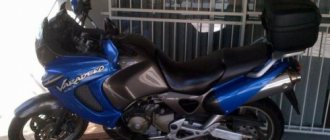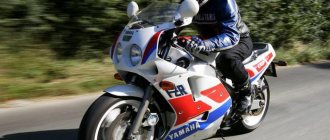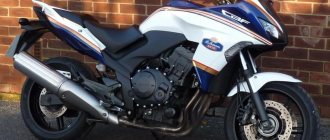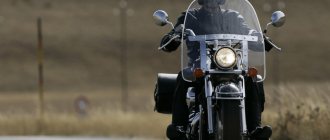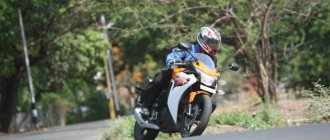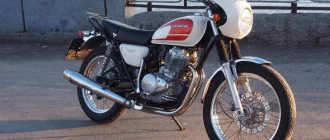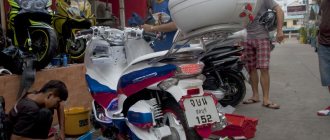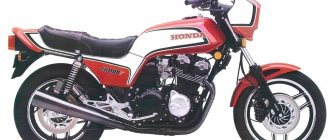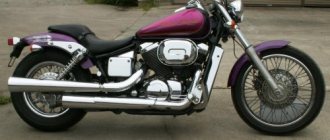- Honda motorcycle model
The Honda VTR1000F sports motorcycle model was introduced in 1997 for the markets of Japan, Australia and Europe. The model also had the Firestorm prefix, but in the North American market it was called differently - Superhawk.
The appearance of the VTR1000 was due to Honda's desire to create a full-fledged sports motorcycle that corresponds to European concepts and ideas about motorcycle construction - in particular, the flagship models of Ducati and Moto Guzzi. The engine from the VT1100 was used as a prototype engine in the early stages of development (1986), but the project was subsequently frozen. They returned to it only in 1994, having seriously revised the configuration of everything - from the design, chassis to the engine.
The model was based on a 2-cylinder V-shaped liquid-cooled engine with a volume of about 1000 cm³, producing up to 110 hp. power and up to 97 Nm of torque. This engine was subsequently used on the model - Honda Varadero 1000.
In 2000, the VTR1000 line was replenished with a new modification, called the Honda VTR1000 SP-1. In the North American market, the model was sold under the name Honda RVT1000R. The model is also known as RC51. The modification was a replica of a racing motorcycle, homologated for public roads. This version was not available in Japan and was only sold in export markets - Europe, North America, Australia.
The Honda VTR1000 SP-1 modification was very different from the basic version of the VTR1000F - a new appearance, fully adjustable suspension, electronic fuel injection instead of carburetors, an increased diameter of the front brake discs, a different engine configuration - improved performance, timing gear drive (instead of a chain on the VTR1000F), changed gear ratios in the gearbox.
In 2002, the modification received some changes and changed its name - Honda VTR1000 SP-2. The changes affected the injection system (the throttle valves were enlarged, the engine is equipped with two injectors per cylinder), suspension and frame configurations, cooling systems, overall dimensions, weight and ergonomics.
2006 was the last year of production of the model, after which it finally left the assembly line and received no further development. In recent years (since 2004), the VTR1000F was not sold in Japan, but was only available in export versions.
Bike features
Here are the main features of the model:
- optimal balance between torque and power;
- compactness and mentality;
- Absolutely typical for sportbikes landing.
The Honda VTR 1000 Firestrom is a quintessential sports bike that looks and rides great even by today's standards. However, don’t think that it can compete with top modern motorcycles.
Review of the Honda VTR 1000 F (Firestorm, Superhawk) motorcycle
I was attracted by the even thrust of the engine; if you don’t rush, it’s quite possible to move like a car, no more than four thousand revolutions per minute, and be ahead of the entire traffic flow. It feels quite confident already from 2000 rpm, the further it goes, the more, without any pick-ups, I haven’t tried it for seven thousand yet and that’s more than enough. The sound is generally superb, it cannot be compared with anything, it resembles a working fighter engine. I advise you to install direct flow without fail, I don’t think you will regret it
The motorcycle is basically okay, but it has its drawbacks: it’s difficult to control at high speeds - 190-200 km/h, high fuel consumption, vibration is felt at medium speeds, but it’s only clogged by the pick-up from 8000 rpm, which is very noticeable. The brakes are really so-so, there have been no questions about them yet, but the engine doesn’t like such speeds. At 27,000 km. While driving, the motor jammed, now I've done everything and am faced with trouble, I need a front cylinder head, an old steering wheel, so think about it.
On Tuesday I drove about 13,000 km. There are no complaints about Motas. I even drove on old oil and thought about cleaning the carbs (it doesn’t start well when cold) - but that didn’t happen. At the service center they said that everything was in perfect condition - like new, even the mechanics had their eye on the bike. It’s a pity that it’s already winter weather, I would have driven and driven. In the cold (well, at an acceptable temperature for a motorcycle, about +3), the engine performed well; when I stopped, the air from the radiator was straight into my hands... Even if you don’t drive, then it’s not that gluttonous for gasoline. And those who rape motos and sports will die. For example, a friend of mine got a Fireblade from the Emirates, almost brand new, but as it turned out, from driving in the back, his engine died... So you have to love your bike)
I'm happy with the motor) the motor is a fairy tale. It pulls like a tractor straight from the bottom. You don't even need to play with the clutch. Lifts onto the skating rink using gas) consumption up to 150 km per hour 6l. 200-220 8-10 liters. It was hard to take turns at first, but then I got used to it))
Second season on the moto, dreamed about it for 5 years. I bought it anyway, I’m completely satisfied, the spark plugs may not be iridium, but then instead of 15,000 km there will be a 5,000 replacement interval, I attached a cooler from the computer to the charging relay (I installed and will install on all my motors), it removes about 12 degrees, which is the same plus , I changed all the incandescent lamps to diodes, including the tidy (it had to be disassembled and the diode strip laid in a circle), which took about 30 watts from the generator, the motor is skpersky, the VE twin rules, just don’t lift it onto the roller, the front cylinder begins to “starve” of oil, with with direct flows the sound is simply amazing! Good luck to everyone on the roads.
The impressions are unique. Firstly, power. The bike was overpowered and at first there was so much power that at first I was afraid to spin it more than 4000 rpm, not to mention just caressing the throttle, let alone unscrewing it) But it feels like it’s not a sportbike at all. Now I’m used to it, but I can’t even remember where and when I turned the knob all the way, probably this has never happened before. The thrust of the engine is such that there is no point in spinning the engine above 7000 rpm at all. In the city, the range of 2500-5000 covers all desires with the top. I really like the powerful engine braking, I use the brakes very little and only at the end of braking. The bike is narrow and I can easily climb into all the cracks in traffic jams and at traffic lights) Very convenient. Surprisingly, even Firestorm’s small windshield copes with its functions perfectly! At 220 km/h, apart from the noise in the helmet and the numbers on the speedometer, there are no negative associations. On the contrary, a partner on a freshly purchased GSX650F complained that after 200 km/h his equipment was torn by the wind and his head was torn off by the oncoming flow... At first he behaved extremely unstable in turns, but after changing the front tire everything became normal. I haven’t driven on my knees in corners yet, but I haven’t experienced any more problems, except for my own self-preservation reflexes) The bike goes confidently along a highway of any quality, it’s not afraid of side winds, I can’t compare it with much, but it’s a fact. During the first week, my hands got used to the unusual loads, and it seems to be normal now. I have reinforced brake hoses, tinted MiRA glass, a steering damper and Ohlins at the rear with all imaginable adjustments. Adjusted, by the way, for a slightly taller person than me. Nobody knows how to lower this? You just can’t turn the nut “stupidly”, its protruding part rests against the “pumping up” hose and the stiffness of the shock absorber, and there is liquid, pressure... You can’t unscrew it. I have a real dilemma) What else I can’t understand, I won’t say that it’s summer, but I drive around the city dynamically, on the highway cruising 140-160, sometimes with lumbago, you know, but my gas mileage stays at strictly 6.2- 6.7l/100km. I’ll say right away, I measure it as it should, at one gas station and by topping it up to full... No, I’m happy with the consumption, I just don’t remember that anyone would indicate, at least close)
Dimensions and weight
Together with a filled fuel tank, the car weighs 220 kg. The gas tank volume is as much as 19 liters, which is very good for a sports bike. However, the fuel consumption here is quite high, and on average it will take from 6 liters to 7 liters per hundred kilometers. The height of the bike at the saddle reaches 813 mm, and the dimensions generally correspond to the framework accepted in the class.
Modifications
In 2000, the developers decided to leave the VTR 1000 F for civilian users, and release another, faster one for racing. Thus, the VTR 1000F SP1 .
The model received separate headlights and more voluminous fairings.
In addition to increasing the speed to 265 km/h, it received new suspensions, dimensions, and a larger diameter front disc.
But the designers did not rest on this. In 2002, VTR 1000 F SP2 . Having all the developments of the first modification, it also changes the cooling system, the front fairing mount, an injector instead of a carburetor, and new wheels.
In small detail, sports developments received several dozen more changes . Considering that even the frame was recalculated during creation, the new models could claim a different designation in the manufacturer’s line, but they were not renamed. But the innovations did not rid the model of its disadvantages.
Chassis and brakes
The frame of the VTR 1000 Firestrom is special: it is made of aluminum, very rigid, injection molded, and also has three sections. The design leaves no doubt that this is a full-fledged sports motorcycle. Strict alloy wheels and a typical steering wheel only confirm this.
Suspension at the rear of the VTR 1000 Firestrom is a monoshock, while at the front it is a 43mm inverted fork. The rear brake is a 220 mm disc and single-piston caliper, and the front is a pair of 296 mm discs with four-piston calipers.
Specifications
The bike received a non-standard motor. A liter of power is produced by 2 pistons operating on a standard 4-stroke circuit. The arrangement is V-shaped.
The two-cylinder “liter” is distinguished by a smooth characteristic, thanks to which the bike accelerates rapidly literally from idle.
- working volume - 999 cm3;
- power - 110 (93) hp;
- number of valves - 8;
- cylinders - 2;
- cooling - liquid;
The radiators of the cooling system are located on the sides of the motorcycle; for better air exchange, cutouts are provided in the plastic fairings.
- fuel supply - carburetor;
- ignition - digital, transistor;
- start - electric starter;
- fuel tank - 19 l.
To comply with Japanese laws, the engine was specially “ strangled ”. The second power is for Japanese models.
Transmission and clutch
They did not reinvent the checkpoint either. The estimated speed can reach more than 200 km? We install a 6-speed.
Lever for switching gearbox operating modes.
Good gear ratios, pedal free play is within normal limits. But the box had one peculiarity. The maximum engine speed, which was recommended by the developers, could only be achieved in 6th gear, and this is a speed of more than 200 km. Not very convenient for the city and not always possible on the highway. The user had two options. Either under-rotate and repair the chassis in the future, or only track racing .
- The main drive is a chain .
- Clutch - multi-disc, oil bath . Tested and tested more than once on other bikes of the brand.
Brakes
This unit was also assembled according to a proven scheme. Hydraulic disc brakes.
Front brakes.
Rear brakes.
Front brakes:
- number of disks - 4;
- diameter - 296 mm;
- support - 2-piston.
Rear brakes:
- number of disks - 1;
- diameter - 220 mm;
- support - 1-piston.
Additional features were installed only on the modified bike.
Tires
They should always be the starting point for improving the “performance” of a motorcycle. With the ubiquitous 180/55-17 and 120/70-17 combination, users have a wide range of choices. You shouldn’t settle for the first sporty or cheapest option you come across. You need to be honest with yourself about your riding style and riding time and choose a tire that can accommodate them all. Modern sports touring tires are much better than those produced in the VTR days.
Some motorcycle owners adhere to the “bigger is better” principle and install a 190 section at the rear, but this is not necessary. The old Bridgestone BT56s were favorites and the new BT010s are still good (expected mileage 4800-6400km). Dunlop Sportmaxes offer even greater durability, albeit less rigidity. Users find the Avon Azaros offer excellent grip in dry conditions and last for ages, although their wet confidence isn't as good as the Bridgestone's.
Flaws
Users noted:
- inconvenient arrangement of instruments and unclear ideas of indicators;
- long travel of the gearbox pedal;
- difficult to find components;
- uncomfortable fit (lower tank);
- uncomfortable mirrors.
Advantages
Those who already use the Firestorm say that the more you ride it, the more they like it. With a certain similarity to a sports bike, the motorcycle is also convenient as a touring option.
- Good handling at any speed (even at the city minimum);
- “Variator”, go to third, and then use the throttle from 0 to 120;
- Quick transformation from one to two-seater (remove the fairing plug behind the driver’s back);
- Acceleration dynamics;
- Trouble-free startup , even at -5.
Advantages:
- Full control over the motorcycle and coordinated operation of all mechanisms makes the Honda VTR 1000 a favorite in many sports competitions.
- Light weight, compact dimensions and good maneuverability make it easy to move around the city.
- Belongs to the budget category.
- With constant care and good maintenance, the service life is quite long.
- Despite the fact that the model is not new, it has a completely modern appearance.
- The engine runs like a Swiss watch. Despite the revs, the sound is clear and dynamic, and acceleration picks up in a matter of seconds.
- A good option for learning how to drive a sportbike.
Behavior on the road
The ride is stable, but not as harsh as a Ducati 996 or R1. The bike's tiny dimensions will likely frustrate riders taller than 1m 75cm more than the shake they might get from the suspension. For a driver of the right size and shape, the Firestorm offers above-average comfort in its class. The VTR1000 has a higher handlebar position than rivals such as the Aprilia Mille, Duke or Suzy TL1000, making the bike a better choice for motorway riding. The model is very close to sports-touring territory, except that the Honda VFR800 or Ducati ST4 have already occupied this niche.
Like many Hondas, the Firestorm is a versatile motorcycle. Driving on the track proves that a car with such a small power reserve can give odds to any other rival. Its stable supply of energy power allows you to sometimes take liberties and avoid consequences. Only the Firestorm front forks dive too much under hard braking, but that's a problem easily fixed for £200.
Dashboard
Owners love its version, produced before 2001, and hate the later one. And vice versa. Early adopters of the Firestorm loved the idea of an LCD fuel gauge and clock, while owners of modified motorcycles said their speedometers were no good. They are only designed to cover 2/3 of the speedometer's full circle, so none of the numbers are where you would expect them to be out of habit. And the dashboard as a whole has become more cluttered.
Rear shock absorbers
The situation with them is the same as with forks. Purchasing new shock absorbers should be the next decision after replacing your tires. A simple replacement will cost £300, but the racing version will cost twice as much. Many users replace shock absorbers with Hagon or Maxton models. Heavier riders can simply change the spring. And sometimes it is enough to add a few washers (3–5 mm).
